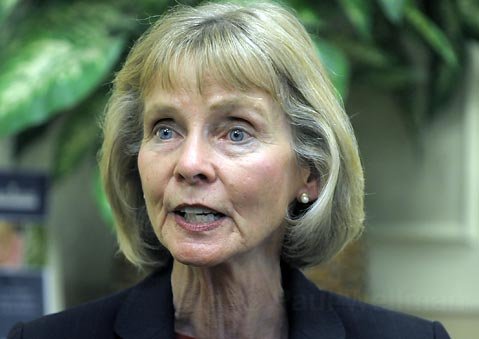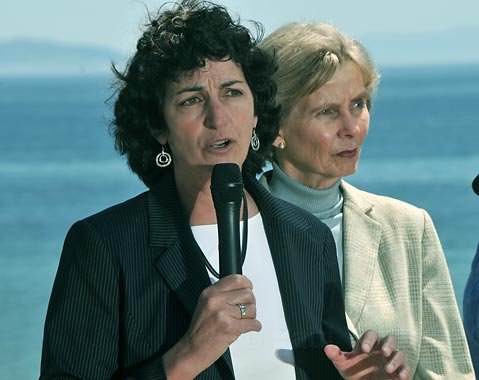Oil Spills Near and Far
Panel Discusses Legislation and Preparation

The vulnerability of Santa Barbara’s coastline has been made all too apparent by the Deepwater Horizon disaster in the Gulf of Mexico, and U.S. Representative Lois Capps, UCSB’s Dr. Ira Leifer, and others shared their expertise on how to best protect the coast.
Both Capps and Leifer, along with Doug Anthony, deputy director of Santa Barbara County’s Energy Division, and Linda Krop, chief counsel of the Environmental Defense Center, spoke at Tuesday’s panel presented jointly by the Citizens Planning Association and the Environmental Defense Center. The panelists presented the facts and consequences of the Gulf oil spill, the legislative achievements and challenges determining the future of offshore drilling, and Santa Barbara’s complex history and unavoidable future with the 20 rigs just several miles off the coast.
“After the spill in 1969 in Santa Barbara, this nation responded with bold and decisive action,” Capps said, recalling how the spill served as a catalyst for landmark environmental policies such as the Clean Water Act and the National Environmental Policy Act. Just as Washington responded to the oil spill more than four decades ago, Capps, who serves on the Energy and Commerce and Natural Resources Committees, praised the House for recently passing the Consolidated Land Energy and Aquatic Resources (CLEAR) Act.

According to Capps, the CLEAR Act, among other things, addresses what she says is the heart of the problems surrounding offshore drilling: the Minerals Management Service. “Countless examples have been uncovered of agency regulators, I might as well say it, sleeping around with instead of keeping an eye on the oil companies,” Capps said. She explained that in addition to fortifying safety procedures for rigs, the CLEAR Act “breaks up the scandal-ridden MMS into different pieces and creates a mechanism for crackdown on ethical lapses.”
Although Capps said the CLEAR Act is a huge step in the right direction, it will not reach the Senate until September. In the meantime, the Gulf still suffers the consequences of the spill. Leifer, who worked with NASA just days after the spill to map the entire Gulf coast and gather data to help gauge the extent of the spill, said that although some of the oil is starting to break up, the long term effects of the spill could be devastating.
One potentially disastrous consequence is the effect the oil that washes ashore has on coastal plants. “That oil doesn’t just stop,” Leifer said. “It goes through the dirt. It kind of seeps through, so the roots of nearby plants, they’re just on borrowed time.” According to Leifer, once you remove these plants, particularly on barrier islands, the coastal areas become much more susceptible to erosion, particularly during major storms and hurricanes.
As it turns out, changes in weather could be yet another consequence of the oil. Leifer said that water generally moves with wind as it blows across the surface, but with oil in the mix, “Suddenly the surface doesn’t move anymore, because it’s got oil, so it calms down. It dies down right at the surface, it changes. One of the things is it actually changes local meteorology, which is not so local when you have a spill that’s a hundred thousand square kilometers.”
An oil spill of that magnitude, according to Anthony, is not in the cards for Santa Barbara. In addition to the fact that Santa Barbara’s rigs have been around for much longer and the reservoirs are more stable than the Deepwater Horizon’s, they are also fixed platforms in shallower water, making a potential spill much easier to fix. Also, the crude oil off Santa Barbara’s coast is thicker and spreads much slower than that under the Gulf. “The challenges, should a spill occur, would not be nearly as great,” Anthony said. However, he noted that Santa Barbara’s drills are much closer to shore, and that the county would have much less time to respond before the oil would make landfall.

Krop explained that with 20 rigs currently offshore, Santa Barbara needs federal protection from the further construction of drills. Although there is already a ban in place for state waters, federal waters could be subject to leasing depending on the whims of whatever administration is in place. If California does not continue to receive protection, as it almost didn’t at the end of the George Bush administration, the feds could potentially sell 486 leases off the tri-county shore.
Capps said she has and will continue to fight for more stringent offshore drilling regulation, because the current policies have not served the country well. “Basically, the American people have been cheated,” she said. “The environment was being degraded, Big Oil was writing their own rules, and now the people in the gulf, and I would say all of us, are paying the price.”


